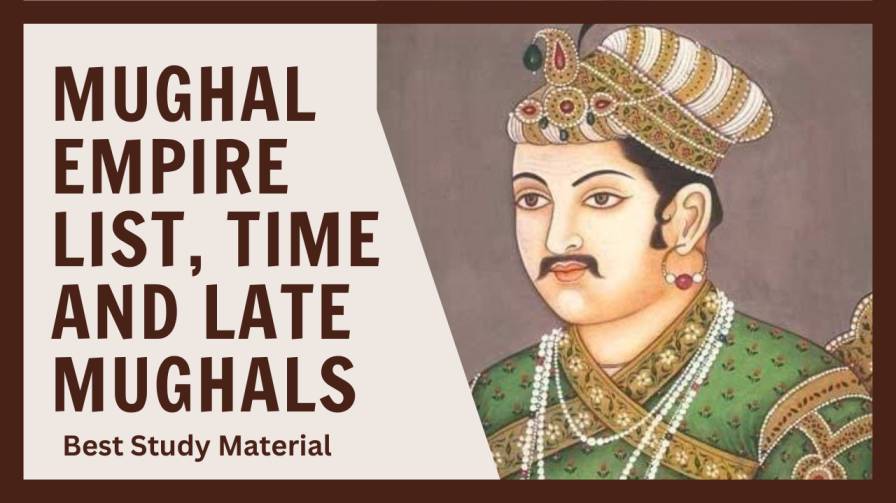Mughal Emperor List: The Mughal Empire is one of the most influential and powerful empires of all time for centuries. The founder of the Mughal Empire was Babur and the Great ruler of all time in the Mughal Empire was Akbar. So here we present the list of all the emperors of the Mughal Empires along with the foundation and their rise.
Mughal Empire
The Mughals ruled over the centuries of the entire Indian continent and extended their empire up to Afghanistan and the Indus Valley in the north to Assam, and Bangladesh in the east to the southern Deccan plateau. During their ruling period, the Mughals have remarked to us about their region’s history, art, architecture, etc. Here to understand their inheritance we should explore the journey of the Mughal Empire and all their descendant.
Mughal Emperor
From the early 16th century to mid 19th century Mughal dynasty was one of the most powerful dynasties of all time in India in shaping the cultural and political landscapes in India. So, here came the list of Mughal Empires which was further classified into Great Mughals and Later Mughals.
List of Mughal Emperor
The list of the Mughals who ruled India from 1526 to 1857 in order are Great Mughals and Later Mughals. The list of great Mughals in systematic order are Babur, Humayun, Akbar, Jahangir, Shah Jahan, Aurangzeb, and in the list of later Mughals in systematic order are Bahadur Shah I, Jahandar Shah, Furrukhsiyar, Rafi Ul-Darjat, Rafi Ud-Daulat, Muhammad Ibrahim, Muhammad Shah, Ahmad Shah Bahadur, Alamgir II, Shah Jahan III, Shah Alam II, Akbar Shah II, Bahadur Shah II.
Mughal Emperor Brief Description
During the time of the Great Mughals (Babur, Humayun, Akbar, Jahangir, Shah Jahan, Aurangzeb), the Mughal dynasty flourished and controlled India with their Political and Intellectual Power. But after the Aurangzeb, the power was going in the hands of Later Mughals which became the main reason for the decline of the Mughal Dynasty. Here we will give a brief description of the Mughals and their successors.
Mughal Emperor (Great)
Muhammad Babur (1526-1530)
The Mughal Emperor Babur also known as Zahir-ud-din Muhammad Babur the successor of Genghis Khan and Timur founded the Mughal Empire in India in 1526. Babur was the first emperor of the Mughal Dynasty who defeated the Last Ruler of Delhi Sultana Ibrahim Lodi in the First Battle of Panipat in 1526 AD and captured India. Babur was famous for their Battle which was fought in India with Rana Sanga and Mahmud Lodi at the Battle of Khanwa and at the Battle of Ghagra. The Babur passed their Empire to Humayun and died at the age of 47 in the year 1530.
Muhammad Humayun (1530-1540 & 1555-1556)
The Mughal Emperor Humayun also known as Nasir-ud-din Muhammad Humayun the successor of Babur came to power after his father’s death. Humayun lost his power and empire after losing two battles “Battle of Chausa” and the “Battle of Kannauj” with the Sher Shah Suri. And after 15 years in Year 1555, he regained his power in India with the support of Office Bairam Khan.
Muhammad Akbar (1556-1605)
The Third Emperor of the Mughal Empire is Jalal-ud-din Muhammad Akbar, the descendent of Humayun. He is crowned to the throne at the age of 13 by Humayun’s Officer Bairam Khan. Under the supervision of Bairam Khan Akbar conquered Hemu (Second Battle of Panipat), Malwa, Gujarat, Chittor, Ranthambore, and many more. The Buland Darwaza was built by Akbar in Fatehpur Sikri after defeating Gujarat in 1572 AD.
He started establishing his revenue system with the help of Finance Minister Raja Todar Mal and the revenue system is known as Zabti System. He also started the Mansabdari System also known as the ranking system for organizing his army. The Navaratnas of this court are Birbal, Todar Mal, Tansen, Abul Fazal, Abdur Rahim, Raja Man Singh, Khan I Khan, Fakir Aziao Din, and Mullah Do Pyaza.
Muhammad Jahangir (1605-1627)
Nur Ud Din Muhammad Jahangir is the son of Akbar and the 4th Emperor of the Mughal Empire. He continued the Religious tolerance policy established by his father and expanded the empire by maintaining relations with neighbors. Abdul Hassan, Bishandas, and Ustad Mansur are some of the well-known painters of Jahangir’s court who have contributed the most to making the court the center of the artistic hub. The Biggest Mistake faced by Jahangir was losing the Kandahar in Persia in 1622 AD.
Muhammad Shah Jahan (1628-1658)
The Fifth Emperor of the Mughal Empire and the successor of Akbar is Shahab-ud-din Muhammad Shah Jahan. He is known for the construction of the Seventh Wonder of the world the Taj Mahal in the memory of his wife Mumtaz Mahal. The other well-known constructions during his reign are The Red Fort and the Jama Masjid in Delhi. During his time he enriched his empire with wealth and Cultures. The Time during which Shah Jahan ruled was also known as the Golden Age of the Mughal Empire. Some of the Famous Italian and French adventurers Manucci, Bernier, and Tavernier visited his court for their artistic work.
Muhammad Aurangzeb Alamgir (1658-1707)
Muhi-ud-din Muhammad Aurangzeb Alamgir is the last emperor of the great Mughals and the successor of Mughal Emperor Shah Jahan. He ruled over the vast empire created by their ancestors but faced many problems because of the strict rules and resistance from the regional powers. Aurangzeb has to face many struggles to control the empires with his brothers Shuja, Dara Shikhoh, and Murad. He also issued Royal Firman again Sati for those who forced widows to burn through Death. He takes the empire to its peak by capturing Kashmir to Jinji from North to South and Hinukush to Chittagong from West to East.
The Later Mughals
In the list of Later Mughals, those emperors come who declined the Mughal empire and did not achieve prosperity because of their lack of ruling skills and the coming of foreign invaders British East India Company.
Bahadur Shah I (1707-1712)
The Mughal Emperor Bahadur Shah I the successor of Aurangzeb face several challenges during their time. Under his reign, it was the start of the decline of the Mughal Empire he put in several efforts to gain regional power but due to political instability, he failed. He was crowned to the Throne at the age of 65 and ruled for 5 years.
Jalandhar Shah (1712-1713)
Jalandhar Shah, who ascended to the throne, was one of the sons of Bahadur Shah. During his reign, he abolished Jizyah, a kind of tax imposed on non muslim communities. Further, his reign lacked of effective governance due to some unpopular initiatives, namely irjarah. It was considered the beginning of the decline of the Mughal Empire in India and thereby East India Company taking control over here.
Farrukhsiyar (1713–1719)
Farukh Siyar, was the grandson of Bahadur Shah and ascended to the throne with the help of Sayyid brothers namely, Hussain Ali Khan and Abdulla Khan. They were later appointed as wazir (prime minister) and Mir Bakshi (Military commander) as a reward for their commitment. He faced invasion by foreign invaders who contributed to weakening the Mughal Empire at large. Eventually, Farukh was overthrown by the Sayyid brothers and assassinated.
Muhammad Shah (1719-1748)
When Muhammad Shah who was also known as Roshan Akhtar and Rangeela came into power, there was continuous downfall and losses of territories and also weaker central authority. Nadir Shah invaded in the territory of Delhi during his reign. He completely plundered the city including the seizure of the peacock throne there. It was also one of the reasons for the quick downfall of the Mughals.
Ahmad Shah Bahadur (1748-1754)
Ahmad Shah Bahadur was the son of Muhammad Shah and proved to be a weak and incompetent ruler as he was ascended to the Mughal throne at a younger age. Safdarjung was his minister and was responsible for initiating the Mughal civil war. He faced various different invasions from regional and foreign powers during his reign. He proved to be a weak ruler and was thereby disposed of by nobles.
Alamgir II (1754-1759)
Alamgir, who acquired the throne with the support of some influential nobles, was the son of Jahandar Shah and was not proven to be an effective ruler within the empire. A conspiracy of murder was planned against him by Sadashivrao Bhau.
Shah Jahan III (1759)
He was the 16th Mughal emperor of India, also called as Muhi-ul-millat, who didn’t rule for a long period and was a puppet emperor. He was being overthrown after the Third Battle of Panipat by Prince Mirza Jawan Bakht.
Shah Alam II (1759-1806)
He was the son of Alamgir II and was considered a powerful ruler during the decline period of the Mughals in India. He was the 17th Mughal emperor also known as Ali Gauhar. He faced numerous challenges and was known for his continuous efforts to resist the British invasion and expansion. He rebuilt the Mughal army and fought the Battle of Buxar (1764) against the invasion by the British East India Company in the territory.
Akbar II (1806-1837)
The second son of Shah Alam II, Akbar ascended to the Mughal throne in 1806 when the Britishers had successfully established their dominance. It was nearly the end of the Mughals, as Akbar II played a minor role in the 1857 revolt for Indian independence. The Mughal Empire was completely demonized after his son Bahadur Shah II, who was the last ruler.
Bahadur Shah II (1837-1857)
Mughal emperor Bahadur Shah II, also known as Zafar was a poet. He was the last ruler of his empire and couldn’t upheld further due to British dominance over the whole territory. His support and help to the Indian Rebellion or Sepoy Mutiny of 1857 led to his exile in Burma and was overthrown.
Mughals Empire Foundation and Rise
The Mughal Empire was founded by Zahir-ud-din Muhammad Babur, popularly known as Babur. He was the descendant of Timur and Genghis Khan and established a Mughal Empire in 1526. He defeated Ibrahim Lodi from the Delhi Sultanate in the First Battle of Panipat, embarking on the commencement of the Mughal Empire over the territory of the Indian subcontinent. Babur’s successors, particularly his grandson Akbar, the Great built and contributed to the mega expansion of the Mughals. The territory experienced a number of significant reforms during his reign including the creation of a centralized bureaucracy, major administration reforms, and many others. During Akbar’s reign, the Mughal Empire saw a huge expansion of territories which encompasses some parts of Pakistan, and Bangladesh as well.
Mughal Empire Cultural and Religious Enrichment
After the Akbar policy of religious tolerance, the Mughal Empire was known for playing an essential role in the enrichment of Cultural and religious tolerance of people. The rulers promoted the tolerance and acceptance of religious diversity which further sought to foster a healthy environment of cooperation. It helps build a mutual understanding between different communities and values towards the rich cultural heritage of India. Akbar, the Great played a crucial role in building the foundation and his successors followed the path. He abolished discriminatory taxes on non muslim communities and encouraged an environment of coexistence. Moreover, the court of Akbar witnessed people from different communities and backgrounds appointed as artists and poets.
Mughal Empire Architecture Legacy
The Mughal Empire’s architectural contribution was the best feature of Indian rich cultural heritage and they built many beautiful monuments, structures, etc. It perfectly reflects a fusion of different cultures of India, Persia, and Asia contributing to a marvelous architectural beauty. Some of the prominent examples of those architectures are Tajmahal, which is also one of the Seven Wonders of the World, Red Fort, Agra Fort, Fatehpur Sikri, Humayun’s Tomb, and many more towns and structures.
Mughal Empire Literature, Art, and Music
There are outstanding achievements in the time of the Mughals in Art, Literature, and Music. As we all know Mughal Emperor Akbar himself had a great love for literature and poetry. The Mughal rulers had great respect for Hindu classical music as Tansen had left a great impact on history.
Mughal Empire Decline
The main reason behind the decline of the Mughal Empire is internal political conflicts and the invasion of the British administration in India. Due to this the rule of the Mughal Empire started to decline in the end the power was surpassed by the Mughals to Colonial Rule.
Read More: Top 35 Career after 12th PCM 2024.







best article ever